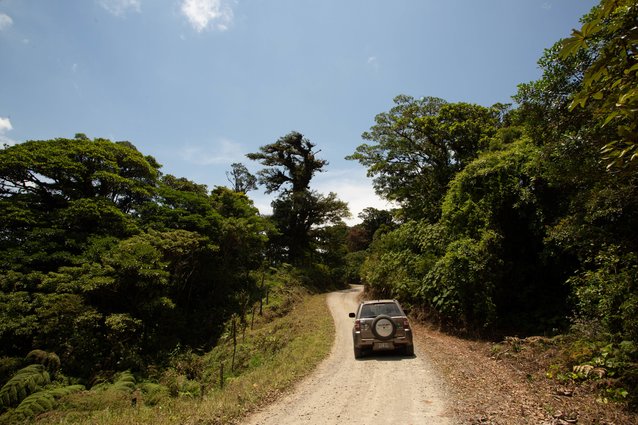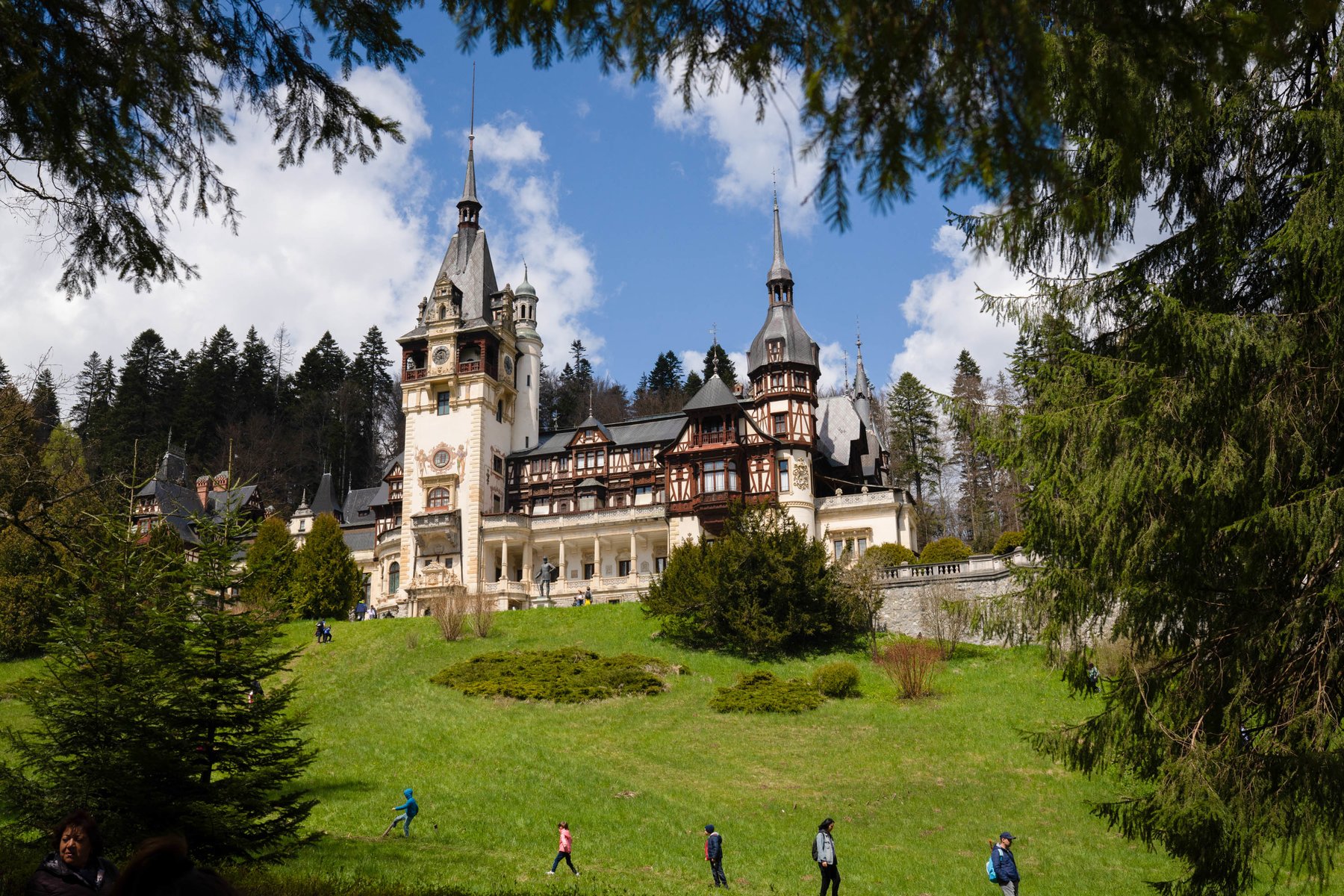Follow Winding Roads Past Scenic Castles in Romania
As it turns out, there’s more to Transylvania than vampires.
By Marah Eakin
Published on 5/5/2023 at 12:00 PM


Peleș Castle in Sinaia, Romania | Photo by Andreea Campeanu for Thrillist
Travelers, start your engines: You are now entering The [Scenic] Route, a rip-roaring exploration of the world’s most incredible international road trips, from lush Rwandan jungles and ancient Peruvian mountains to seaside Irish villages, dreamy Japanese forests, and twisty Romanian hillsides. For more reasons to hit the pavement—plus tips, interviews, and a custom road-ready playlist—cruise over to the rest of our coverage here.
Renting a car in a foreign country can seem like a daunting prospect. After all, road signs aren’t universal, working a stick shift can be tricky, and sometimes people drive on the left side of the road. But there’s nothing like hitting the road in some new place. Take Romania, for example. Its capital city Bucharest has long drawn the lion’s share of tourists, but while it’s a great place to visit, you’ll need a car to see all the coolest destinations beyond the city; think turreted medieval towns, ancient castles, and the most photogenic twisty road you’ve ever encountered.
That’s why, if you’re considering visiting the former Eastern Bloc nation, we recommend making Bucharest a starting point, rather than a final destination. Once you’ve had your fill of the big city, rent a car and check out Transylvania, which encompasses much of the central part of the nation and is about much, much more than just vampires and gory legends.
Here’s our guide to a Romanian road trip full of big city beauty, medieval charms, and that aforementioned curvy, curvy road.
Portia Hart, founder of Blue Apple Beach | Photo by Victoria Holguín for Thrillist
Best time of year to travel to Romania
While much of Romania never really dips before 40 degrees Fahrenheit, if you’re looking for beautifully green vistas, the joys of European outdoor dining, and weather comfortable enough for a nice dip in a mineral spring, you’re going to want to go between May and October. Summer travel to Europe can be pricier, but fortunately Bucharest isn’t always a top tier destination like Paris or London, and flights can be found for a reasonable price. Additionally, the American dollar goes pretty far in Romania, so even if you have to pony up slightly more than you’d like on a flight, you’ll spend less than you might expect on meals, hotels, and even a rental car.
Mediaș | Photo by Andreea Campeanu for Thrillist
How to rent a car in Romania
Renting a car in Bucharest can be slightly confusing, if only because car rental companies often offer rentals both at the local airport and in different parts of the city. Keep it easy in Bucharest and rent from a company at the airport—you’ll find noted brands like Sixt and Alamo at the on-site rental center.
One essential note: You will need an international driving permit plus a valid U.S. driver’s license to operate a vehicle in Romania. You’ll want to do that before you leave the States, and the permit is pretty easy to obtain. Just stop in at your local AAA or AATA office, where it’ll only set you back about $20 (or just apply by mail). If you’d like to know more, there’s plenty of information on this site.
Renting a car in Romania is, thankfully, extremely affordable. You can snag one starting at about $15 a day, though the vehicle might be pretty small at that price. If you’re planning on driving a good bit and have some luggage, consider up-sizing to something a bit bigger. It’ll only bump up the cost by about $10 or so per day, and you’ll be glad you did it. Also, if you can’t drive an automatic car, make sure you request a car with an automatic transmission. It’s easy to do: Just tick the preference box on whatever car rental site you’re using, and you should be good to go.
Whatever you choose, you can rest assured you’ll be driving on the right side of the road, making the whole experience a little easier.
Kick things off in Bucharest
It’s only natural to start your Romanian journey in Bucharest, given that that’s probably where you’ll be flying into. It’s the largest city in the country, and acts as the country’s cultural, economic, and governmental center.
There was an architectural and cultural boom in the latter part of the 19th century, leading to the city being dubbed “the Paris of Eastern Europe,” and a good deal of those stately buildings and artistic hubs still remain today. Take a walking tour around town to check them out, or dive headfirst into them at Caru’ Cu Bere, a Belle Epoque beer hall that’s been in operation since about the 1880s. Make a reservation if you want to go for dinner, because visitors always clamor for their take on classic Romanian fare.
Bucharest slipped into Communist control after WWII, which led to lean times for the population—and to the construction of massive concrete apartment blocks and enormous brutalist buildings and statues. Longstanding dictator Nicholae Ceaucescu was deposed in 1989 and things started to change for the better, but if you’re interested in what life was like under communist rule, you can’t go wrong with a private driving tour focusing on the era. The guide will drive you around town in an era-appropriate car like a vintage Trabant, and you’ll get to pepper them with all your nosy questions. Some tours also include a stop at Ceaucescu’s former home, which is well-worth a stop, if only for the stunning (and stunningly hypocritical) tile mosaic around its indoor pool.
Related: This Bohemian Capital Is One of Europe’s Most Exciting Cities Right Now
Other worthwhile stops while puttering around Bucharest include Hanu’ Berarilor for more beer and game meat, the folk art-filled National Museum Of The Romanian Peasant, and the endlessly Instagrammable bookstore Cărturești Carusel.
It’s best to stay centrally in the capital and voyage out from there. The Europa Royale is well-located and affordable, costing just about $100 a night. The Epoque and The Marmorosch are slightly more expensive but beautiful and well worth the splurge.
Test your ride along the Transfăgărășan Road
One of the country’s most traveled roads ever since it made an appearance on Top Gear in the UK, the wildly wiggly Transfăgărășan was built in the 1970s by Ceaucescu, who wanted a way to trek troops across the Fagaras Mountains in the event that Russia invaded. If you love driving—or even if you don’t—you really shouldn’t pass up a chance to drive the Transfăgărășan. It’s eye-poppingly gorgeous, and the experience is truly singular. Just make sure the road is open before you go; it’s closed November 1 through June 15 each year.
You can get there from Bucharest by taking the A1 toward Pitesti and Curtea de Arges. The Transfăgărășan officially starts around Albestii de Arges and then climbs steadily toward the little town of Capatenii Pamantului. That’s where the road’s serious (and “eek!”-inducing) hairpin turns really begin. Take the road to the top and you’ll glimpse Balea Lac, as well as a picture-perfect view of the whole Transfăgărășan. Take the road down toward Cartisoara and then hop on the DN1 toward Avrig to reach your next destination.
Take the Transfăgărășan Road to Sibiu
A well-preserved medieval town, Sibiu is a great entry point into Transylvania. Nicknamed “the town with eyes” for its many of the buildings with peering rooftop windows, Sibiu is full of historic and interesting places to explore. Start your visit off with a walk around the town’s beautiful central square and then head over to the Brukenthal National Museum to check out some art. Climb the stairs at the Evangelical Cathedral in Huet Square, which was built between 1322 and 1520, and then strut down May 9th Street and New Street, both of which are lined with homes first built around the same time.
Since you’ve got a car, you’ll also be able to check out the ASTRA Museum of Traditional Popular Civilization, which is about three miles outside town. The largest open-air museum in Europe, the ASTRA sits on 96 acres of beautiful land and invites visitors to glimpse into the region’s history and traditional Romanian peasant life.
Continue on to Mediaș
Another classic Transylanian town, Mediaș is a great place to stop for a look at a few fortified churches, or a nice dip in one of Romania’s beloved medical spas. The Bazna spa is located just out of town and is hailed for its therapeutic mud and mineral waters, both rich in Bazna salt. It’s reportedly great for rheumatic and nervous system issues, and visitors to the spa can take a dip in the indoor pool or indulge in one of many treatments available on site, like galvanic baths, hydrotherapy, and a mud wrap.
Next up: Sighișoara
Let’s get this out of the way: The legend of Vlad The Impaler looms large in Romania and in particular in Transylvania, where stories have run rampant for years. Much of it is total nonsense, but if you can embrace the camp of the whole endeavor, it is possible to have a little fun with it.
Take, for instance, the town of Sighișoara, which claims to be the birthplace of the legendary tyrant. Another charmingly preserved medieval town, Sighișoara boasts a beautiful walled old town, which is on the UNESCO list of world heritage sites. There are centuries-old buildings everywhere the eye can see, including dozens of homes dating back more than 300 years. One of those, the Casa Vlad Dracul, allegedly housed the impaler for a period and now contains a Dracula-themed restaurant on the first floor. After lunch, dip into the spooky Dracula Investigation for an even more in-depth look at his life, or shop one of the many stores around town selling all manner of Vlad-themed wares, from eye-popping squeeze dolls to macabre t-shirts.
Related: The Real Dracula Castle in Transylvania Throws the Best Halloween Party
End your journey in Brașov
If you didn’t get enough Vlad in Sighișoara, you’re in luck: Bran Castle, which was supposedly once occupied by the legendary Impaler, is located just outside Brașov. It’s a massively popular (and fairly cheesy) tourist attraction, but if you know that going in, you should be able to appreciate all the camp. Formerly acting as a medieval fortress and a home to Romanian royalty, Bran Castle is now mostly just a hotspot for those who love legends and stately European homes.
If you love a good castle but camp isn’t your thing, there’s always Peles Castle, which sits between Brașov and Bucharest and was built in 1875. It’s a stunning neo-Renaissance building, and it looks right out of a fairy tale. In fact, it’s actually been used as a fairy tale castle in a number of Hollywood productions, including A Christmas Prince back in 2017.
All castled out and more interested in staying in town? Check out Brașov’s old town hall square and Black Church, the gothic cathedral that got its name after a great fire in 1689. Walk Rope Street, which at four feet wide is Europe’s narrowest, and then take a cable car up Tampa Mountain to check out the view from the Hollywood-like Brașov sign. There’s amazing food and nightlife all over town, too, so grab a spot at an outdoor cafe for dinner and do a little people watching before bouncing back to Bucharest the next day to return your car.
Marah Eakin is a contributor for Thrillist.
Want more Thrillist? Follow us on Instagram, TikTok, Twitter, Facebook, Pinterest, and YouTube.
Sighișoara | Photo by Andreea Campeanu for Thrillist